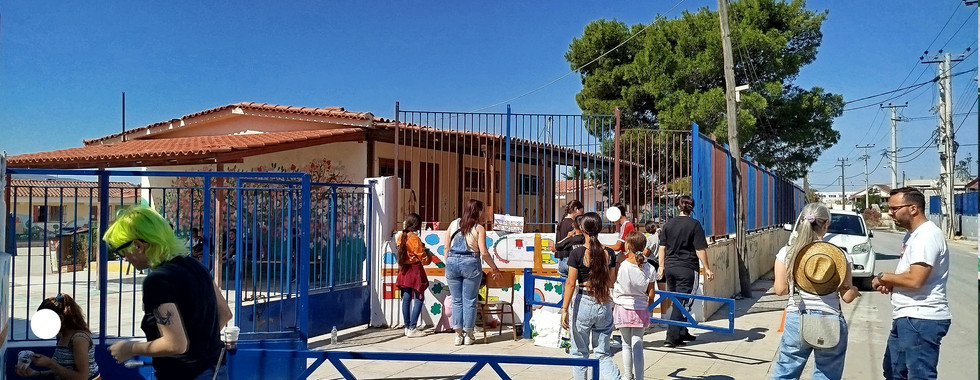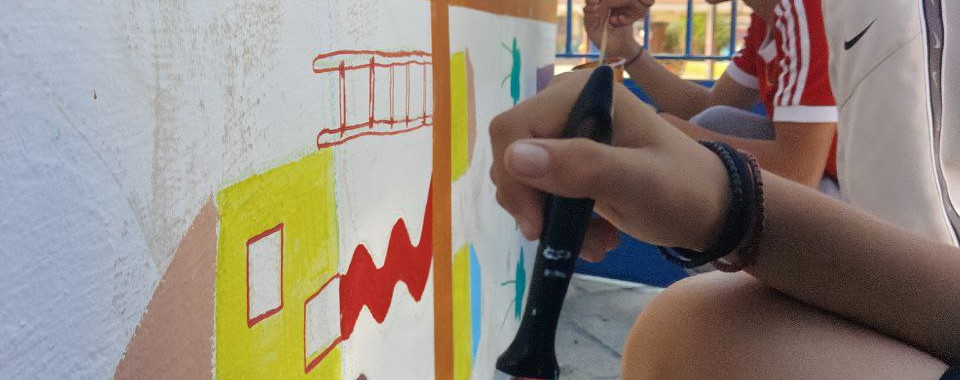“From Home to School: Adding Colour to the Route”: Participatory Design with Roma Students of the 7th Primary School of Aspropyrgos in West Attica
- Artemis
- 4 days ago
- 4 min read
In spring 2025, 6th Grade students of the 7th Primary School of Aspropyrgos in the Nea Zoi Roma settlement took part in a participatory design program organised by West Attica Fairville Lab. The pedagogical activity that was co-produced together with the school’s teaching staff aimed to actively involve children in reimagining and improving the public space of their neighbourhood, amplifying their voices and creativity. Throughout a series of 5 workshops, the children explored concepts related to public space, the environment, socio-spatial inequalities, and participatory design. They shared observations, exchanged ideas, and collaboratively designed their vision for the route from home to school. The final result took the form of a mural, painted at the school entrance by the students during the program’s closing event.

Nea Zoi, the area where the school workshops took place is one of the most deprived Roma settlements in the Municipality of Aspropyrgos and the largest of its kind in Greece, with around 2.650 inhabitants. The settlement is located just half a kilometre from the Fyli landfill, the country’s biggest dumpsite, and lies within an extensive industrial zone including the Hellenic Petroleum facilities (ELPE), hazardous waste plants, chemical industries and scrap yards. Inside the settlement itself many families live in makeshift shelters without access to basic infrastructure such as running water and electricity, while most residents are pushed into precarious, informal recycling work that exposes them to daily environmental risks.
At the heart of the settlement stands the 7th Primary School of Aspropyrgos, a vital point of reference for the community. Despite challenges such as school dropout, the dedication of the principal and teaching staff has turned the school into more than an educational institution, by taking on a supportive role, helping families navigate bureaucratic procedures, and offering mediation when needed. According to the 6th grade teacher, the school is “a beacon for the community, the only stable public service in the area and a safe space for children to learn, grow, and imagine a better future”.
Figure 2: The yard and the surroundings of the 7th Primary School of Aspropyrgos in Nea Zoi. 05.03.2025
West Attica Fairville Lab’s goals through the workshop cycle with Roma students of the Primary School in Nea Zoi were not only to introduce the children to participatory design, its methodology, and tools, but also to explore the potential of schools as entry points for engaging with the Roma community. The workshops aimed to open channels for dialogue with parents and the broader neighbourhood, identifying ways to co-produce knowledge, pedagogic content, and community initiatives in collaboration with the school’s teaching staff. By co-designing a mural with the students that remains as a permanent feature of the school and its surroundings, the program sought to amplify children’s voices, create visible outcomes for the community, and foster early opportunities for inclusive, participatory approaches that link environmental awareness, social inequalities, and collective action in Nea Zoi.
In total, 20 students from the 6th grade class took part in the workshops, 8 boys and 12 girls between 12 and 14 years old. Since this was their first experience with participatory design, both content and methodology were adapted along the way. The workshop cycle unfolded in five key steps and was built upon one guiding question: “What is missing from your neighbourhood, and what would you like it to have?”

The workshops began with a participatory exploratory walk around the school, where students documented their impressions and reflections in notebooks with words and sketches. They noted broken sidewalks, garbage piles, the smell of burning copper, and nearby factories, yet also highlighted positives, such as their school and friends. When asked what they would like to see in their neighbourhood, the answers were clear: playgrounds, football fields, trashcans, sidewalks, and safe crossings. Their observations set the foundation for the following steps. At the second workshop the students were introduced to the concepts of public space, participatory design, environmental inequality, and active citizenship. Students collectively mapped positive and negative aspects of their neighbourhood, discussing that public space belongs to everyone and should reflect the voices of its users. In the third step, students started designing together in groups. They worked on axonometric maps and proposed features and amenities for the neighbourhood, drawing colourful schools, green spaces, playgrounds, and sports fields. Despite differences, their shared priorities (cleanliness, greenery, and spaces for play) revealed a common vision of the neighbourhood. This led naturally to the fourth step, where children translated their ideas into sketches and a collective mural design, voting on the final composition layout. At the last workshop the students painted their vision of Nea Zoi on the school’s entrance wall together with their teacher and members of Fairville Lab team. The mural remains a colourful testimony of how children see and imagine their neighbourhood.
Figure 4: Collective mural on the wall of 7th Primary School in Nea Zoi representing “The 6th Grade’s Vision for the Neighbourhood. 03.06.2025
The conception of the program, the structure of the activities, and the pedagogic materials were developed collaboratively with the 6th grade teacher and the school principal, who contributed their knowledge of the students’ needs, rhythms of school life, and sensitivities within the Roma settlement. Parents were introduced to the project during the school’s annual closing event, although their participation remained limited, highlighting broader challenges of community outreach in Nea Zoi. Despite this, the program functioned as an important step towards building trust and co-producing local knowledge about environmental deprivation, inequalities, and everyday experiences. The insights gathered from the students will directly inform the Atlas that the Lab is developing for West Attica.
This program was made possible thanks to the collaboration of the school community, especially Principal Matina Vavouli, teacher Panagiotis Anastasopoulos, and the enthusiastic students of class ST’3.
Up next, a photo gallery capturing moments from the workshops and the mural painting day, as well as a fanzine presenting the process step by step.
































Comments